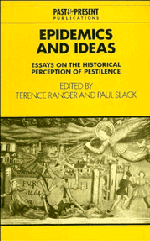Book contents
- Frontmatter
- Contents
- Contributors
- Preface
- 1 Introduction
- 2 Epidemic, ideas and classical Athenian society
- 3 Disease, dragons and saints: the management of epidemics in the Dark Ages
- 4 Epidemic disease in formal and popular thought in early Islamic Society
- 5 Plague and perceptions of the poor in early modern Italy
- 6 Dearth, dirt and fever epidemics: rewriting the history of British ‘public health’, 1780–1850
- 7 Epidemics and revolutions: cholera in nineteenth-century Europe
- 8 Hawaiian depopulation as a model for the Amerindian experience
- 9 Plague panic and epidemic politics in India, 1896–1914
- 10 Plagues of beasts and men; prophetic responses to epidemic in eastern and southern Africa
- 11 Syphilis in colonial East and Central Africa: the social construction of an epidemic
- 12 The early years of AIDS in the United Kingdom 1981–6: historical perspectives
- Index
- Past and Present Publications
7 - Epidemics and revolutions: cholera in nineteenth-century Europe
Published online by Cambridge University Press: 05 August 2011
- Frontmatter
- Contents
- Contributors
- Preface
- 1 Introduction
- 2 Epidemic, ideas and classical Athenian society
- 3 Disease, dragons and saints: the management of epidemics in the Dark Ages
- 4 Epidemic disease in formal and popular thought in early Islamic Society
- 5 Plague and perceptions of the poor in early modern Italy
- 6 Dearth, dirt and fever epidemics: rewriting the history of British ‘public health’, 1780–1850
- 7 Epidemics and revolutions: cholera in nineteenth-century Europe
- 8 Hawaiian depopulation as a model for the Amerindian experience
- 9 Plague panic and epidemic politics in India, 1896–1914
- 10 Plagues of beasts and men; prophetic responses to epidemic in eastern and southern Africa
- 11 Syphilis in colonial East and Central Africa: the social construction of an epidemic
- 12 The early years of AIDS in the United Kingdom 1981–6: historical perspectives
- Index
- Past and Present Publications
Summary
The fall of the Duvalier regime in Haiti, it has recently been claimed, is the first revolution to have been caused by AIDS. In July 1982 the New York Times reported that the killer disease not only affected gays but was endemic, for reasons that seemed frighteningly obscure, in Haiti as well. The publicity subsequently accorded to this revelation ensured that the number of American tourists visiting Haiti fell from 70,000 in the winter of 1981–2 to a mere 10.000 the following season, with worse to come in the subsequent three years. Tourism was the second biggest source of income for the impoverished Haitian state, and the collapse of the industry sparked off an economic crisis with mounting unrest met by growing repression, and ending with the ousting of the president-for-life, ‘Baby Doc’ Jean-Claude Duvalier (himself by this time rumoured to be suffering from AIDS) early in 1986. AIDS is not the first epidemic disease to have been credited with overthrowing a regime. In Plagues and Peoples, his panoramic survey of the impact of disease on human history, William H. McNeill has put forward a whole range of examples of the ways in which micro-organisms have destroyed or transformed state structures in the past, from the Roman Empire to the pre-Columbian Incas and Aztecs, whose civilisation was destroyed not so much by the small bands of conquistadores under leaders such as Cortez and Pizarro as by the diseases, new to the Americas and therefore devastating in their impact, which the Spaniards brought with them.
- Type
- Chapter
- Information
- Epidemics and IdeasEssays on the Historical Perception of Pestilence, pp. 149 - 174Publisher: Cambridge University PressPrint publication year: 1992
- 13
- Cited by



